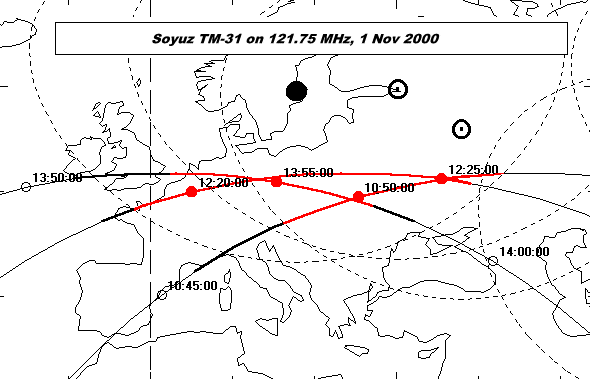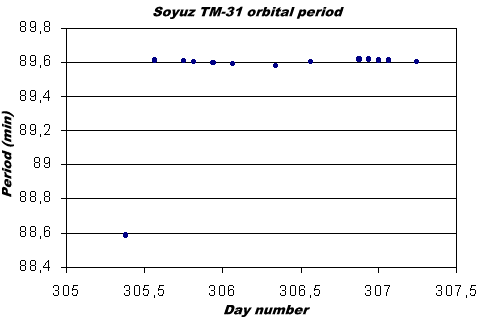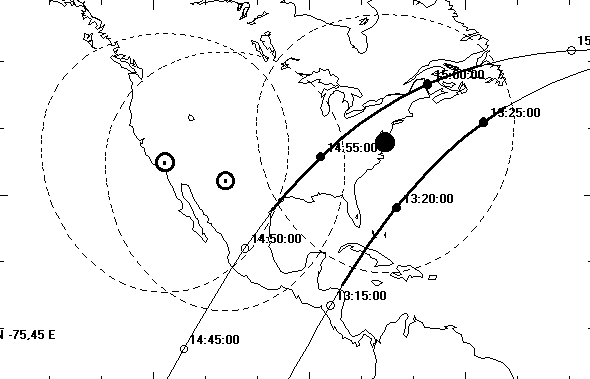
 The
Soyuz TM-31 spacecraft carrying commander Yuri Gidzenko, flight
engineer
Sergei Krikalev, and Expedition-1 commander Bill Shepherd of NASA
was launched into fog from the "Gagarin pad" at the Baikonur cosmodrome
in Kazakhstan at 0753 UT on Oct 31. The crew used Gidzenko's callsign
"Uran"
during their flight in the Soyuz.
The
Soyuz TM-31 spacecraft carrying commander Yuri Gidzenko, flight
engineer
Sergei Krikalev, and Expedition-1 commander Bill Shepherd of NASA
was launched into fog from the "Gagarin pad" at the Baikonur cosmodrome
in Kazakhstan at 0753 UT on Oct 31. The crew used Gidzenko's callsign
"Uran"
during their flight in the Soyuz.
During the first day,
the
orbit was raised to a period of 89.6 minutes which was maintained up to
the point when the final climb to ISS was initiated on 2 November (see
figure on the right).
During 31 october I was
at
work all day, so I tried pick up Soyuz TM-31 on 121.75 MHz with my
computercontrolled
time switch for the radio and tape recorder, but - to my surprise - the
Windows clock did not run properly and all recordings were made 10
minutes
too late. When I rebooted the computer the problem disappeared.

The crew's mike was
open
during the passes, but they did not say much. On the 1353-1356 UT pass
they reported an engine burn and kept using the term "illuminatora
VSK".
This referred to condensation of water near the periscope in the
descent
module of the Soyuz, specifically the viewing screen. The advise from
the
ground was to switch on electrical heating and ventilator near
port-hole.
On the next pass reports from Chris van den Berg and other trackers in Europe showed that the crew still used 121.75 MHz and that they reported on hatch opening (which occured at 1023 UT).
My autorecording system
only
permits the radio to be tuned to one frequency and I had banked on the
crew swicthing to the good old Mir frequency (VHF1) of 143.625 MHz soon
oafter entering ISS. However, it took until three hours after docking
before
they appeared on this frequency. However, when they finally did, I was
rewarded by a message in which Bill
Shepherd thanks ground crews in English (92 kB,mp3) (1227 UT, 2
Nov
2000). On the next pass Chris van den Berg heard the crew call at
1356.11
UT: TsUP THIS IS ALPHA, HOW DO YOU READ?? This was
somewhat
of a coup from the crew and NASA Administrator Goldin had to approve
'Station
Alpha' as the ISS callsign for the duration of the first expedition.
Data bursts similar to
those picked up from mir were heard on 143.625 MHz. Listen to this
excerpt recorded at about 1240 UT. According to a message on
Hearsat-L
from Ivan Artner these bursts are probably "the 1200Baud radio
amateur
AX.25 packet radio system often heard from MIR when they were in range
of russian tracking stations. This system is ham radio gear but often
used
for official traffic with TsUP for transfering lists, files etc. so
while
it's for ham use I think that the russians found it reliable and handy
for daily work..(at least much better than their 100Baud teleprinter
system
was)".
 Use
of VHF ground stations in the United States
Use
of VHF ground stations in the United StatesFor example, on 4
November,
2000, Jim Kunowsky near Richmond, Virginia and Ron Boyle at Hornell,
New
York picked up solid voice on 143.625 MHz during the passes shown in
the
map below (which shows the coverage zones around stations at Wallops
Island,
White Sands, and Dryden Flight Center)
The crew will use the communications equipment of Zvezda and Zarya for communications with both flight control teams (Moscow and Houston) and the S-band communications gear in the Unity. So mainly the same frequency as those during MIR-operations will be in use. In the future the crew gets also the possibility to use Ku-band links via TDRS , but this will be much later. The equipment for that purpose is in the recently(during mission STS-92) installed Z1 structure.